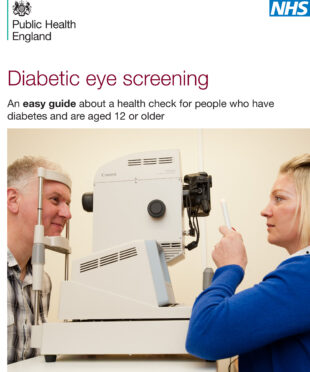
Screening is a choice, but some unwanted and unfair barriers mean screening is harder to access for certain groups, including people with learning disabilities.
Today, in line with the PHE Screening inequalities strategy, we published an updated version of our easy guide to diabetic eye screening.
This information leaflet aims to help make diabetic eye screening more accessible to people who have a learning disability or who struggle with written English.
The easy guide is based on the information in our standard national leaflet. We have made the content easier to read by writing in clear, simple sentences and using photos and artwork to illustrate each important message.
The easy guide to diabetic eye screening explains:
- why the NHS offers screening
- what to expect on the day of the test
- the possible benefits and risks of accepting the offer of screening
- possible screening results
Expert group makes sure information is fit for purpose
In 2016, PHE Screening set up an expert group to develop accessible screening information for people with learning disabilities.
This group, which includes screening providers and commissioners, learning disability clinicians and service user ‘experts by experience’, also helped us put together easy read versions of the Screening tests for you and your baby, AAA screening, bowel scope screening and breast screening leaflets.
The most important members of the group are the service users with learning disabilities. They again emphasised the need for information to be clear, concise and unambiguous in our updated easy guide to diabetic eye screening leaflet.
The revised leaflet is available on GOV.UK for local screening providers to download and print out as required. We hope providers and service users alike find it helpful in improving equality of access to diabetic eye screening.
Inequalities work in progress
Publication of the new easy guide to diabetic eye screening contributes to our objective of producing new or revised easy guides to all the population screening programmes in line with Accessible Information Standard legislation.
We hope this will help make sure people with learning disabilities have clear, accessible information they can understand in order to make a choice about the offer of screening.
Our focus will now switch to developing an updated easy guide to cervical screening along with generic easy read screening invitation letter templates for all 5 national young person and adult screening programmes. We also plan to develop new online guidance for health professionals to support people with learning disabilities in enabling them to access breast screening and diabetic eye screening.
PHE Screening blogs
PHE Screening blog articles provide up to date news from all NHS screening programmes. You can register to receive updates direct to your inbox, so there’s no need to keep checking for new blogs.
2 comments
Comment by Irene Stratton posted on
There's no reason why the 'easy guide' shouldn't be used for everyone. A colleague has worked on the issue of 'easy' versions of leaflets and found that nobody minds being sent a leaflet which is clear and easy to read - as long as it's not labelled "easy guide"!
Could a sentence be included to say that diabetes can cause problems which might not affect vision immediately? Often people who do not come for screening say "I don't have any problems with my eyes so I don't need to be screened".
Comment by Mike Harris posted on
Thank you for your feedback Irene.
We will take it into consideration when we review and revise the easy guide.